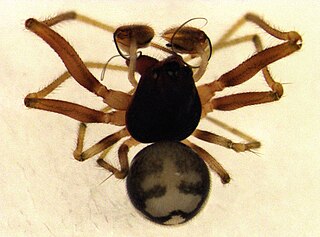Zealanapis australis is a spider species in the genus Zealanapis found in New Zealand.

Novanapis is a genus of South Pacific araneomorph spiders in the family Anapidae, containing the single species, Novanapis spinipes. It was first described by Norman I. Platnick & Raymond Robert Forster in 1989, and has only been found in New Zealand.

Hanea is a monotypic genus of Cyatholipidae containing the single species, Hanea paturau.

Algidiella is a monotypic genus of spiders in the family Anapidae. It was first described by Rix and Harvey in 2010. As of 2023, it contains only one species, Algidiella aucklandica.

Pacificana is a genus of spiders in the family Miturgidae. It was first described in 1904 by Hogg. As of 2017, it contains only one species, Pacificana cockayni, found in New Zealand.
Bealeyia is a monotypic genus of Polynesian araneomorph spiders in the family Orsolobidae containing the single species, Bealeyia unicolor. It was first described by Raymond Robert Forster & Norman I. Platnick in 1985, and is only found in New Zealand.

Forstrarchaea is a monotypic genus of shield spiders from New Zealand containing the single species, Forstrarchaea rubra.

Aotearoa magna is a species of spiders in the Mecysmaucheniidae family. It was first described in 1949 by Forster. As of 2017, it is the only species in the genus Aotearoa, erected by Forster and Platnick in 1984. It is found in New Zealand.
Ascuta ornata is a species of Orsolobidae spider of the genus Ascuta. The species is endemic to New Zealand.
Pounamuella vulgaris is a species of Orsolobidae. The species is endemic to New Zealand.
Subantarctia turbotti is a species of spider in the family Orsolobidae. The species is endemic to New Zealand.
Tangata alpina is a species of Orsolobidae. The species is endemic to New Zealand.
Tangata stewartensis is a species of Orsolobidae that is endemic to New Zealand.
Waiporia algida is a species of Orsolobidae that is endemic to New Zealand.
Waiporia extensa is a species of Orsolobidae that is endemic to New Zealand.
Waiporia hornabrooki is a species of Orsolobidae that is endemic to New Zealand.
Waiporia modica is a species of Orsolobidae that is endemic to New Zealand.

Zearchaea fiordensis is a species of Mecysmaucheniidae spider that is endemic to New Zealand.
Toxopsiella lawrencei is a species of Cycloctenidae spider endemic to New Zealand.
Pholcomma antipodianum is a species of cobweb spider that is endemic to New Zealand.








